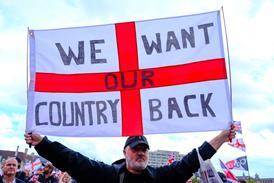What is the ethnic pay gap and why should Christians campaign on it?
By  Sarah Edwards2023-06-05T10:26:00
Sarah Edwards2023-06-05T10:26:00

On average, minority ethnic staff earn less than their white colleagues in the UK. If we are to tackle racial injustice, companies must be transparent about their ethnicity pay gap, says Sarah Edwards
The cost of living crisis is hitting all of us hard, but its effects are being felt most intensely by the minority ethnic groups that are disproportionately represented in low-income homes in the UK. A 2020 study of racial inequalities found that Black African or Bangladeshi households had approximately 10p for every £1 of white British wealth. Insulating against poverty – and the stress and obstacles that come with it – has always been much harder for these groups, and it has been exacerbated by the challenges of recent years.
Related articles
-
 Opinion
OpinionThe greatest wealth transfer in history is underway and the Church is uniquely positioned to support it
2023-10-27T13:31:00Z By Ken Costa
In the coming years, Boomers will hand over an unprecedented $100 trillion of wealth to the next generation. Ken Costa explains how the Church can help Zennials manage their money appropriately
-
 Opinion
OpinionRev Carmel Jones (1937-2023): The visionary founder of the Pentecostal Credit Union
2023-07-31T13:46:00Z By Marcia Dixon
As the Christian community mourns the passing of a Windrush pioneer, Marcia Dixon pays tribute to a trailblazer who bought financial services to a community excluded from mainstream banking
-
 Opinion
OpinionLily Phillips has been baptised. I pray it's accompanied by change
2026-01-06T08:15:00Z By Lois McLatchie-Miller
The baptism of a pornographic actress has caused controversy, but the real question isn’t whether Lily Phillips’ sins are too great for God’s grace – it’s whether she truly understands what repentance means, says Lois McLatchie-Miller
More from Culture
-
 Magazine Features
Magazine FeaturesThe Gospel according to John Lewis: How Christmas ads reveal our culture’s longing for meaning
2025-12-19T15:08:00Z By Martin Saunders
From tear-jerking rom-coms to cuddly penguins, these expensive TV commercials have become a major talking points in recent years. They often hint at Christian themes too – you could even call them modern-day parables, says Martin Saunders
-
 Magazine Features
Magazine FeaturesKPop Demon Hunters: What should Christians make of the biggest film of the year?
2025-11-27T15:41:00Z By Martin Saunders
The biggest movie in Netflix history was released this summer, but you’ve probably never considered watching it. Martin Saunders explains what you need to know about KPop Demon Hunters – and considers how Christians should respond to the phenomenon that is anime
-
 Reviews
ReviewsFaithless: The story behind Bruce Springsteen’s soundtrack to a lost ‘spiritual western’
2025-11-07T16:06:00Z By Maddy Fry
Maddy Fry reveals the untold story behind Bruce Springsteen’s mysterious soundtrack Faithless, written for an unmade Martin Scorsese film about a Catholic nun and an outlaw
- Issues
- Topics A-Z
- Writers A-Z
- © 2025 Premier Christianity
Site powered by Webvision Cloud
























